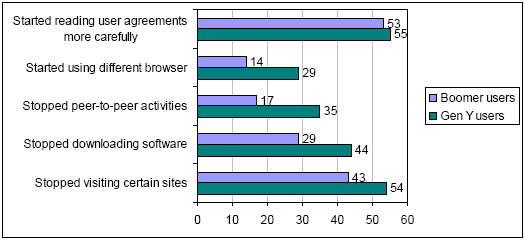Are “Wired Seniors” Sitting Ducks?
Currently, the vast majority of Americans age 65 and older do not go online. But that will likely change in a big way as the “silver tsunami” of internet-loving Baby Boomers swamps the off-line senior population in the next 10 years. That demographic shift, paired with a rising tide of viruses, spyware, and other online critters, is cause for concern since there is evidence that older users are less likely than younger ones to take precautions against software intrusions and fraud.
The truth about “wired seniors”
“Wired seniors” (internet users age 65 or older) are often cited as the fastest-growing demographic group online, but that description can be misleading. Most of the growth in this group over the last few years has come from long-time internet users in their early sixties aging into senior status. There is little evidence that many non-users in their seventies and eighties are suddenly getting the internet bug.
In January 2006, the Pew Internet & American Life Project found that 34% of Americans age 65 and older go online, up from 29% in January 2005. But a closer look at the data reveals that just 28% of Americans age 70 and older go online – essentially the same percentage as in January 2005 (26%). By contrast, internet access is near-universal for Americans under the age of 60: 89% of 18-28 year-olds, 86% of 29-40 year-olds, 78% of 41-50 year-olds, and 72% of 51-59 year-olds go online. About half (54%) of 60-69 year-olds go online.1
The common perception of the timid older internet user is quite accurate, even for relative newcomers to the ranks of seniors. Wired seniors are less likely than internet users under the age of 65 to have tried a wide range of online activities, possibly because they are not in the market for as many types of information as younger users who might be doing schoolwork, trolling for dates, or scanning employment listings online.2 In addition, researchers at Fidelity Investments have identified “cautious clicking” as a behavior trait of many older internet users who may share a sense that one false move on the Web could land them in unknown or unsafe territory.3
Younger internet users take more chances online, but also take more precautions
Internet users in their twenties are more likely than those in their fifties and sixties to have traveled far and wide online, trying new things and possibly learning hard lessons about the dangers that lurk on the network. In a survey focused on the impact of software intrusions on the internet, the Pew Internet Project found that younger internet users are more likely than older users to say they have spyware on their home computers (45% of internet users ages 18-28 report having spyware, compared to 27% of internet users ages 51-59). With the exception of reading user agreements more carefully, internet users between 18 and 28 years old are also more likely than those in their fifties to make changes in their online behavior to avoid getting unwanted software programs on their computer.4

Older people are less vulnerable – but also less careful – in their offline security
Online behavior patterns echo offline experiences of both older and somewhat younger Americans. According to a January 2006 report by the Council of Better Business Bureaus and Javelin Strategy, Americans between the ages of 25 and 34 are twice as likely as Americans age 65 or older to be victims of identity fraud.5 However, in a further parallel with the Internet Project’s spyware findings, a 2004 study by the AARP found that younger people–at least those in their middle years—are more likely than older people to take action to protect themselves against fraud.
Among Americans ages 45-54, 84% say they have regularly reviewed their credit card or other financial statements in the past two years, compared with 69% of Americans age 65 and older who have done so. Forty-one percent of Americans ages 45-54 have ordered and reviewed a copy of their credit report, compared with 19% of Americans age 65 and older who have taken this action in the past two years. Thirty percent of Americans ages 45-54 have told the three major credit bureaus that they do not want to receive unsolicited financial offers in the mail, compared with 22% of Americans age 65 and older who have done so.6
Perhaps as they attain the status of seniors, these now cautious and experienced internet users will continue their prudent habits. And there is another reason to hope that older Americans will adapt to an increase of threats. Internet users who say they have had spyware infiltrate their computer are more likely than other users to say they have taken action to prevent another intrusion. Old and young alike adhere to the old adage, “once burned, twice shy.”
About The Pew Internet & American Life Project
The Pew Internet & American Life Project is a non-profit initiative, fully-funded by The Pew Charitable Trusts to explore the impact of the internet on children, families, communities, health care, schools, the work place, and civic/political life. The Project is non-partisan and does not advocate for any policy outcomes. For more information, please visit our website: https://legacy.pewresearch.org/internet/.


